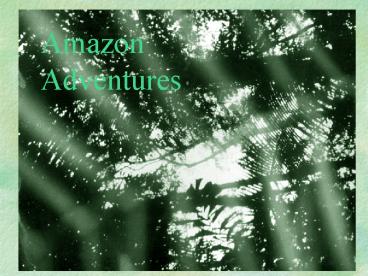Amazon Expedition 1992 - PowerPoint PPT Presentation
1 / 36
Title:
Amazon Expedition 1992
Description:
Bufo frog. Just a sample of butterflies. Amazon Bats. This bat is an Artebius ... Poison Dart frog. The skin of these tiny frogs secrets a strong poison ... – PowerPoint PPT presentation
Number of Views:97
Avg rating:3.0/5.0
Title: Amazon Expedition 1992
1
Amazon Adventures
2
Peru
- The trip started at Iquitos, Peru
- Traveled by river boat up the Napo to Napo Camp
- Traveled back along the Amazon River
3
Amazon Diversity
- Over 90,000 species of plants have been
identified - New plants are discovered every day
- Almost 1/3 of the worlds 8,700 species of birds
are found in the Amazon Basin - The Peruvian Amazon possesses the richest
butterfly fauna in the world with over 4,000
species described - Estimates of fish in the Amazon river approximate
3,000 species - more than in the entire Atlantic
Ocean
4
The River Barge
- No Roads or cars
- Travel was done by river boat
5
The Napo Camp
- One large building covered by thatch roof
- No walls
- No private rooms
- We washed in a bucket on the edge of the floor
6
ACEER
- Amazon Center for Environmental Education
Research - Canopy Walkway was built in 1991
- Multilevel walkway that is 1/4 mile long
- Very primitive at the time of our visit - much
more advanced now
7
Canopy Walk
- First year of canopy walk
- extends 85 feet above the forest floor
- This person was being very brave because she is
afraid of heights - Research platforms for study of canopy organisms
8
- A tropical forest is characterized by
broad-leafed evergreen trees that form a
continuous canopy. - These forests receive at least 100 inches of
annual rainfall. - These forests occupy less than 7 of the worlds
land area, they are home to more than half of the
worlds plant and animal species.
9
Some of the Plants and Animals
Bufo frog
10
Just a sample of butterflies
11
Amazon Bats
- This bat is an Artebius
- Large insect-eating bat
- It was captured over water
12
Rare Sucker-footed Bat
- These bats hang upright on the underside of leaves
13
Kissing Macaws
Snacking on Bananas
14
White-eyed Parrot
15
Elusive Hoatzen
16
Caiman
17
Nellie the tapir
- Tapirs are the largest members of the pig family
- Nellie lived at the camp and could easily be fed
by hand
18
Three-foot earthworm
- This 3 foot earthworm was captured during a rainy
evening - Natives eat these worms
19
Poison Dart frog
- The skin of these tiny frogs secrets a strong
poison - Natives tip their darts with this poison to stun
prey
20
Piranhas
21
What a Piranha bitecan do
22
Canduru
- The canduru is a tiny catfish found in the Amazon
River - It is attracted to urine and will follow a trail
to the source - These catfish get lodged in the urethra and can
only be removed by surgery - We were instructed not to urinate in the water!
23
People of the Amazon Basin
24
At a Village
- Orejones (?) Indians
- This boy was learning to juggle from one of the
people on the trip
25
A typical home
26
Typical Amazon Kitchen
27
The School
- Schools about every 20 miles along river
- Teacher has a college degree
- 44 students - grades 1-6
28
The Yagua Indians
29
Tasting Musato
- Musato is the local liquor
- Manioc is chewed and mixed with saliva
- Allowed to ferment for a few weeks
- Drink up!
30
Amazon Expedition 1991
31
Amazon Expedition 1992
32
Why care about Rain forests?
- The rainforests produce 20 of our atmospheric
oxygen - 25 of all prescription drugs in the U.S. are
derived from rainforest plants -examples quinine
for malaria, curare for anesthesia during
surgery, secretions from an Amazonian frog to
treat strokes, seizures, and Alzheimers disease,
The Rosy Periwinkle used to treat lymphocytic
leukemia - gives a 99 remission rate. - More than 1,400 varieties of tropical plants are
thought to be potential cures for cancer
33
- Common products that come from the rainforest
Bananas, avocados, pineapples, peppers, peanuts,
oranges, papaya, lemon, pepper (the spice),
coconut, sugarcane, cassava and cacao (chocolate
is made from this). Cashew, brazilnuts, coffee
beans all originated in the tropics. Chicle
which is used in chewing gum comes from a tree in
the tropics. - Oil from the cacao seed is used in cosmetics and
soaps. The kapok tree produces a silky, water
resistant fiber used in life preservers, pillows,
upholstery, and insulation. Latex, made from
rubber trees is used in making tires.
34
- The rain forests moderate global climate.
- Chopping and burning of rain forests releases
significant amounts of carbon dioxide. - Approximately 25 of the Earths species will be
extinct by the middle of the 21st century if the
destruction of rain forests is not slowed - The loss of diversity resulting from rain forest
destruction may be the worst ecological disaster
of the millennium. Loss of potential foods,
medicines, and genetic material to rejuvenate
existing plants is irreversible.
35
Deforestation
36
Rainforest Destruction
- Every day over 214,000 acres of rain forest are
destroyed - Scientists estimate that one rain forest species
becomes extinct every 15 minutes due to loss of
its habitat - Almost 65 of Central America has been cleared to
create pastureland for grazing animals - Rainforest land cleared for pasture or farming
quickly degrades and must be abandoned - Costa Rica loses 2.5 tons of topsoil to erosion
for every kilo of meat exported, a farmer can
make 86 times as much money per acre with coffee
and 284 times as much with bananas as with beef.































